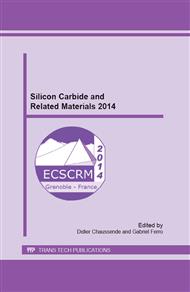p.769
p.773
p.777
p.781
p.785
p.789
p.793
p.797
p.801
The Influence of Neutron Irradiation on Electrical Characteristics of 4H-SiC Power Devices
Abstract:
Commercial 1200V and 1700V MPS diodes and 1700V vertical JFETs produced on 4H-SiC n-type epilayers were neutron irradiated with fluences up to 4x1014 cm-2 (1 MeV neutron equivalent Si). Radiation defects and their effect on carrier removal were investigated by capacitance deep-level transient spectroscopy, I-V and C-V measurement. Results show that neutron irradiation introduces different point defects giving rise to deep acceptor levels which compensate nitrogen doping of the epilayer. The carrier removal rate increases linearly with nitrogen doping. Introduced defects deteriorate ON-state characteristics of irradiated devices while their effect on blocking characteristics is negligible. The effect of neutron irradiation can be simulated by TCAD tools using a simple model accounting for introduction of one dominant deep level (Z1/Z2 centre).
Info:
Periodical:
Pages:
785-788
Citation:
Online since:
June 2015
Authors:
Keywords:
Price:
Сopyright:
© 2015 Trans Tech Publications Ltd. All Rights Reserved
Share:
Citation:


